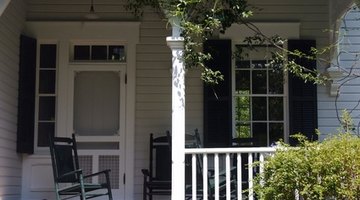House Styles in the 1940s and 1950s
Home design and decor has changed a lot since the 1940s and 1950s. As tastes, styles, technology and building processes evolve, so, too, does a home's design. The suburbanization of large swaths of the country following World War II also had a major impact on the styles of houses.
Interior Design

Beginning in the 1940s, more homes began to include wall-to-wall carpeting, breakfast nooks and family rooms. The centerpiece of a living room changed from the fireplace to the television, as TV became popular in the 1950s. Hardwood flooring was replaced by checkerboard vinyl in the 1950s. Other features of the 1940s and 1950s included all-new fitted kitchens and combined eating and living areas in living rooms.
Exterior Features
The size of lots decreased after the war to accommodate more homes during a period of rapid growth. The attached garage emerged as a new, standard feature. By 1950, 45 percent of all new homes included an attached garage or carport. Meanwhile, the front porch declined in popularity during the century's middle decades, partly because of the reorientation of family entertainment from outdoor leisure to indoor television watching.
Furniture
The large phonograph machine, the television and brightly colored furnishings were typical of the 1940s and 1950s. Formica worktops, painted cupboards and chrome appliances appeared during this time. New materials, such as foam rubber, changed the appearance and design of furniture and popularized low-slung armchairs and recliners.
Architectural Design
Much of the suburbanization that took place during these decades was driven by the proliferation of tract homes, houses built cheaply, quickly and uniformly. Assembly-line manufacture and the use of prefabricated building materials made tract home construction possible. The "ranch house" style typified this architectural trend. Ranch houses, pioneered by Cliff May, originated in California and spread throughout the country. The Cape Cod house was another architectural model that became popular. Cape Cod homes were based on a classical New England style, featured living rooms, dining rooms and attached garages, and were used as the basis for some planned communities, such as Levittown. Split levels (or "raised ranches") were another popular architectural model.
References
Resources
Writer Bio
David Ferris started writing professionally in 2006 and has been published in several newspapers. He has worked in a variety of fields including education and law. He strives to one day be an authority on all subjects, great and small. Ferris has a Bachelor of Arts in political science.
Photo Credits
- home sweet home image by David Dorner from Fotolia.com
More Articles



